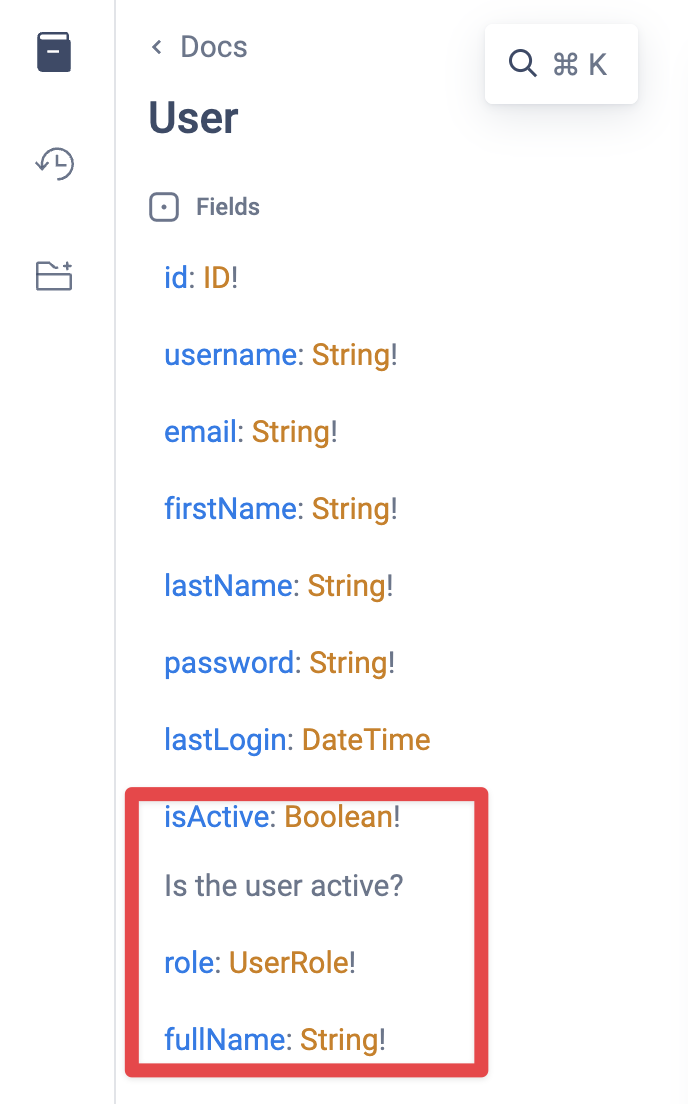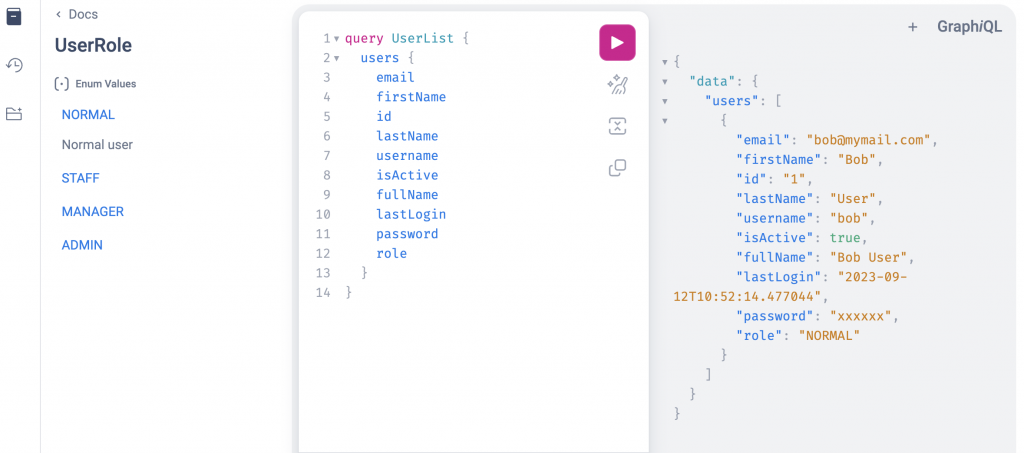接著繼續編輯 User Type 進一步增加欄位與學習 Strawberry 的 GraphQL 型態。
@strawberry.type
class User:
id: strawberry.ID
username: str
email: str
first_name: str
last_name: str
password: str
last_login: typing.Optional[datetime.datetime]
- is_active: bool = True
+ is_active: bool = strawberry.field(
+ default=True,
+ description="Is the user active?",
+ )
在這邊我們將 is_active 原本的預設值改成使用 strawberry.field,它提供一些額外的功能讓我們可以對欄位增加一些客製化功能,像是上面我們使用 description 來幫欄位增加說明,並顯示在 Schema 上面。
strawberry.field還可當成 裝飾器(Decorator) 來使用,其包裹的函式就是作為 resolver 來使用,像是下面的 full_name 欄位:
@strawberry.type
class User:
id: strawberry.ID
username: str
email: str
first_name: str
last_name: str
password: str
last_login: typing.Optional[datetime.datetime]
is_active: bool = strawberry.field(
default=True,
description="Is the user active?",
)
+ @strawberry.field
+ def full_name(self) -> str:
+ return f"{self.first_name} {self.last_name}"
然後再增加一個使用者角色的欄位,這個欄位我們使用 Enum 來表示使用者角色有特定的選項值可以使用:
import datetime
+import enum
import typing
import strawberry
+@strawberry.enum
+class UserRole(enum.Enum):
+ NORMAL = strawberry.enum_value(
+ "normal",
+ description="Normal user",
+ )
+ STAFF = "staff"
+ MANAGER = "manager"
+ ADMIN = "admin"
@strawberry.type
class User:
id: strawberry.ID
username: str
email: str
first_name: str
last_name: str
password: str
last_login: typing.Optional[datetime.datetime]
is_active: bool = strawberry.field(
default=True,
description="Is the user active?",
)
+ role: UserRole
@strawberry.field
def full_name(self) -> str:
return f"{self.first_name} {self.last_name}"
建立了一個 UserRole 的 enum Type,列舉出使用者角色有普通使用者(normal)、員工(staff)、管理者(manager)以及系統管理者(admin),然後可以使用 strawberry.enum_value來幫 Enum 值增加說明,然後幫 User Type 增加 role 欄位來表示使用者角色。
最後一樣建立一個物件,來看看上面增加的欄位在 GraphiQL 上面 Schema 呈現的樣子。
def get_users() -> typing.List[types.User]:
return [
types.User(
id=1,
username="bob",
email="bob@mymail.com",
first_name="Bob",
last_name="User",
password="xxxxxx",
last_login=datetime.datetime.now(),
+ role=types.UserRole.NORMAL,
),
]
然後我們就可以啟動 strawberry debug server,在瀏覽器上面試試看這次的修改內容。
$ strawberry server main:schema
Running strawberry on http://0.0.0.0:8000/graphql 🍓

GraphiQL 上面可以看到 Schema 增加這些欄位、說明與型態。

上面是展示查詢結果,可以看 role 顯示的值是 Enum 的成員名稱,而非 Enum 的成員的值。
以下是這次的完整程式碼:
# app/types.py
import datetime
import enum
import typing
import strawberry
@strawberry.enum
class UserRole(enum.Enum):
NORMAL = strawberry.enum_value(
"normal",
description="Normal user",
)
STAFF = "staff"
MANAGER = "manager"
ADMIN = "admin"
@strawberry.type
class User:
id: strawberry.ID
username: str
email: str
first_name: str
last_name: str
password: str
last_login: typing.Optional[datetime.datetime]
is_active: bool = strawberry.field(
default=True,
description="Is the user active?",
)
role: UserRole
@strawberry.field
def full_name(self) -> str:
return f"{self.first_name} {self.last_name}"
# app/query.py
import typing
import datetime
import strawberry
from app import types
def get_users() -> typing.List[types.User]:
return [
types.User(
id=1,
username="bob",
email="bob@mymail.com",
first_name="Bob",
last_name="User",
password="xxxxxx",
last_login=datetime.datetime.now(),
role=types.UserRole.NORMAL,
),
]
@strawberry.type
class Query:
users: typing.List[types.User] = strawberry.field(resolver=get_users)
users 其實也可以使用函式的形式實現,就如同上面所描述的將strawberry.field當成裝飾器。
@strawberry.type
class Query:
# users: typing.List[types.User] = strawberry.field(resolver=get_users)
@strawberry.field(description="Get all users")
def users() -> typing.List[types.User]:
return get_users()
